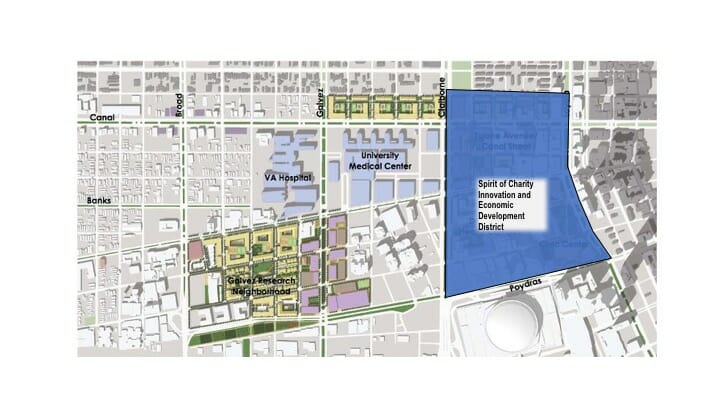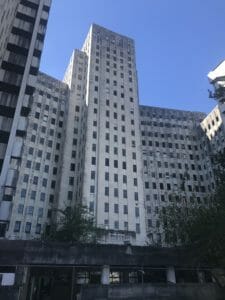Top Story
Date: November 5 – 10, 2017
Location: New Orleans, LA
Sponsor: The Real Estate and Facilities Foundation of Louisiana State University and LSU Health Sciences Center
Subject Area: Adaptive Reuse and Downtown Revitalization
Panel Chair: John Walsh, TIG Real Estate, Frisco, TX
Background and Panel Assignment
New Orleans is renowned for being a city of art, culture, food, and, since 2005, survival and rebirth. While the majority of the City has rebuilt and grown, there still remain sites sprinkled throughout that lay as daily reminders of the devastation of Hurricane Katrina. The ULI Advisory Services panel was asked to examine and provide recommendations about what is the highest and best use of the former Charity Hospital building, which has remained inactive since the Storm. The former Charity Hospital building is 20 stories and 1,000,000 square feet located in New Orleans’ Central Business District.
The Real Estate and Facilities Foundation (REFF) of Louisiana State University (LSU) asked the panel to find an adaptive use for the former Charity Hospital building. REFF asked the panel to consider this reuse as critical to the continued development of downtown New Orleans and the adjacent neighborhood. The panel was given two primary questions to consider:
- What is the highest and best use of the Charity Hospital building?
- How can REFF and LSU Health Sciences Center realize the maximum benefit of outsourcing the redevelopment of Charity Hospital to a private developer? Maximizing benefit means finding a use that would work in synergy with the BioDistrict and the LSU Health Sciences Center, a use that would accelerate after development in the BioDistrict, and a use that would be of financial benefit to the REFF.
Summary of Recommendations
The redevelopment of Charity Hospital represents a once-in-a-generation opportunity to not only catalyze its neighborhood but also establish a “New Orleans global example” of ethical and inclusive revitalization. Based on the background materials provided, site tours, and onsite interviews, the panel made the following key recommendations:
- The Charity Hospital Building must remain in place. This is the baseline of all of the panel’s recommendations. Immediate actions should be taken to stabilize the building to ensure that it does not further degrade prior to reuse.
- The panel recognizes that to create a sustainable pathway to shared prosperity, all stakeholders need to work together in new and innovative ways. The panel has established concurrent processes for receiving Requests for Qualifications (RFQs) and Requests for Proposals (RFPs) for the reuse of Charity Hospital and the establishment of an Economic Development, tax increment finance (TIF) district. Both processes should be transparent and identify when public comment is accepted.
- Any reuse of Charity Hospital and revitalization of the surrounding neighborhood should ensure that the panel’s guiding principles are executed. These principles include (1) incorporating the “spirit of Charity”; (2) implementing a clear and transparent process; (3) ensuring inclusive and equitable processes and outcomes; (4) ensuring that reuse and revitalization encompass financial feasibility and stewardship; (5) maintaining flexibility as a tenet of good planning; (6) including a public use and community benefit component in reuse of the former Charity Hospital building; (7) improving connectivity; (8) establishing partnership and collaboration; (9) ensuring high-quality design and construction; and (10) translating vision into a strategic plan.
- A multistakeholder coordinating committee (The Charity District Coordinating Committee or CDCC) should be established to facilitate the revitalization goals of the Spirt of Charity Innovation and Economic Development District and develop a strategic plan. The CDCC would develop and oversee the implementation of administrative procedures for the district and ensure that the activities and initiatives of the bio, research, medical, teaching, and innovation/tech stakeholders are coordinated and putting energy and resources toward common aims.


